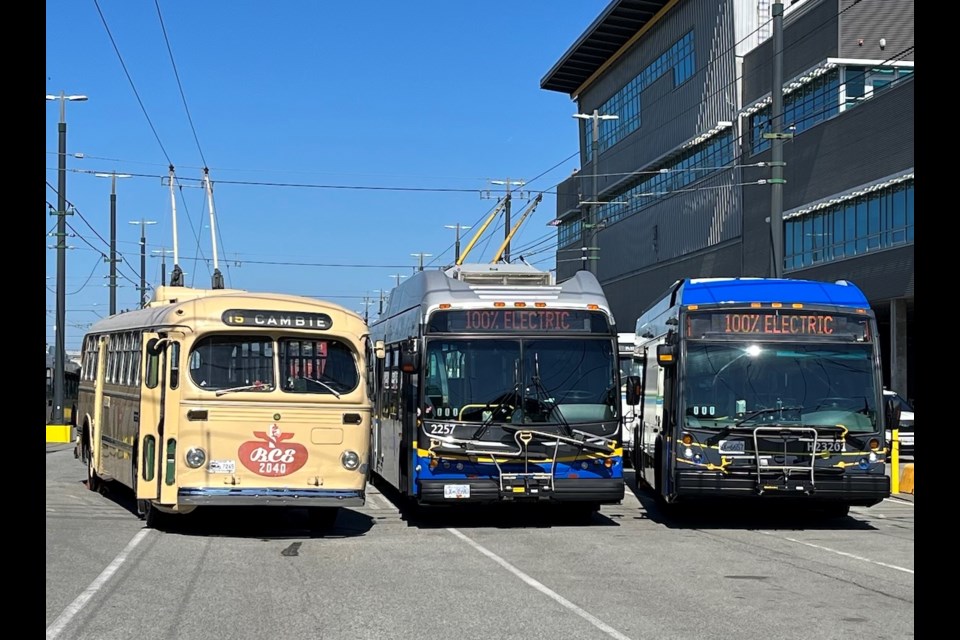On August 16, 1948, the first 30 trolley buses rolled into service in Vancouver.
The first trolley bus route was called the Fraser-Cambie. It started service at Queen Elizabeth Park, went over the Cambie Street Bridge, through Chinatown, and down to Marine Drive and Fraser Avenue, according to TransLink.
In August 1976, the last Brill trolley bus was retired, after a 28-year run. Between 1948 and 1976, a total of 364 Brill trolley buses had driven the streets of Vancouver.
Fast forward 75 years later from day one in 1948, and the modest fleet of 30 trolley buses has grown to 262, currently serving 13 routes in Vancouver and Burnaby.
Using overhead trolley wires, trolley buses are powered by electricity; BC Hydro, previously known as BC Electric, used to run the transit system and the hydroelectric-powered streetcars and interurbans trolleys that crisscrossed the Metro Vancouver region.
Trolley buses 'revolutionized' how people moved around Metro Vancouver
However, in the post-WWII era, the idea was to go from "rails to rubber," and replace the streetcar infrastructure with buses powered by overhead trolley wires, serving the same routes.
The trolley bus "revolutionized how people travelled around the region," said Kevin Quinn, TransLink's CEO, during a press conference on Aug. 15 held at the Vancouver Transit Centre in Marpole.
Quinn and other elected officials, and one very special guest - retired trolleybus driver Angus McIntyre - spoke in front of a trio of electric buses: A 1947 Brill restored by the Transit Museum Society, a contemporary trolley bus, and one of the new battery-electric buses in TransLink's growing fleet.
McIntyre moved to Vancouver with his family in 1965, and shortly after graduated from Point Grey Secondary. He embarked on his bus driving career soon after, ending up serving a whopping 41 years in the driver's seat of many a trolley bus.
Today, McIntyre still enjoys driving historic buses as his hobby. He's one of a few drivers who can take the wheel of the Transit Museum Society's two restored and fully operational Brill trolley buses, one from 1947 and one from 1954.
Wearing his old uniform and carrying his old change box, McIntyre took a moment to reflect on his storied career driving trolley buses in Vancouver, and to note the hard work of the volunteers at the Transit Museum Society, which formed in 1986 to ensure the preservation of Vancouver's transit history.
Taleeb Noormohamed, MP for Vancouver-Granville, recalls the thrill of riding the trolley buses daily in his youth, and wondering if it might come off its wires.
Those wires are such an iconic part of the city's urban landscape. Today, with over 100,000 weekday boardings on trolley buses, the infrastructure continues to allow TransLink to move towards its goal of being fully zero-emission. Overall, according to Quinn, just over half the kilometres logged by passengers on TransLink buses are zero-emission.
From Brill trolleys to an all-electric wire-free line
"Trolley bus technology has proven it can stand the test of time," said Sean Fraser, Canada's Minister of Housing, Infrastructure and Communities, noting the significant role viable public transit options have in people's decisions on where to live and work in and around Vancouver.
"These trolley buses are vital," remarked Burnaby's mayor, Mike Hurley, Vice-Chair of the Mayors’ Council on Regional Transportation. "Every person who takes a trip [on a trolley bus] is making a responsible choice, making a difference," he added.
With the second-largest fleet of trolley buses in North America - and the only Canadian city to operate trolley buses - Vancouver's trolleys are "an iconic bus that's come a long way, and played a key role in serving the needs of the region," said Michael McDaniel, President and General Manager at Coast Mountain Bus Company.
In 2021, TransLink pledged to significantly increase the number of battery-electric buses in its fleet as part of its mission to be zero-emission. Earlier this year, line 100, serving Marpole, took its first steps towards becoming the first all-electric route in the system; TransLink presently has four Nova LFSe+ brand electric buses on Route 100 and will be adding 15 more by 2024, to fully electrify the route.
Though TransLink's future may be a bit more wireless, "trolleys will remain an iconic symbol," said McDaniel.
Marking the 75th anniversary of the trolley bus in Vancouver
On Aug. 16, TransLink will mark the 75th anniversary of Vancouver's historic trolley bus fleet by teaming up with the Transit Museum Society to offer free rides on its two restored Brill trolley buses.
Rides will be available first-come, first-served from 9 a.m. to 4 p.m. departing from outside Waterfront Station.
Additionally, TransLink will release its commemorative limited-edition Mini-Trolley Compass Keychain that same day.
The Mini-Trolley Compass keychains will be available at the TransLink Customer Service Centre at Waterfront Station, beginning at 8 a.m., and are only available while supplies last, with a two-per customer maximum.



